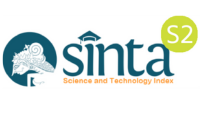THE INFLUENCE OF UPIN AND IPIN ANIMATION ON CHILDREN'S RELIGIOUS LIFE
DOI:
https://doi.org/10.31330/penamas.v36i1.650Keywords:
Education;, Islam, Media; , Impact, ChildrenAbstract
As we know, animation or cartooning is one of the most effective media to convey a message to children. It's the same with the Upin and Ipin series. This product from the neighboring country turns out to be not only entertaining but also implies a message and a mandate. Islam has taught that each of us is a brother and must remind each other of goodness. Upin and Ipin may be one of the media for da'wah if it can be easily conveyed, especially for children who are not yet baligh. The purpose of this study is to determine the effect of the animated series Upin and Ipin on the life of the Muslim religion for children because, more or less, television and the programs contained in it help children grow and develop. Through library studies based on several references and accompanied by surveys, Upin and Ipin turned out to have a good influence. They feel there is a moral message related to religion in the series.
References
Arifin, Z., Siddiqi, B. A., Hamdun, D., & Rahmi, S. (2021). The Impact of Masturah Program on The Families of Tablighi Jamaat at Temboro Village in Indonesia. Nazhruna: Jurnal Pendidikan Islam, 4(1), 136–149. doi: 10.31538/nzh.v4i1.1128
Fitriyati, H. B. N. (2020). Pengaruh Terapi “Kidung Wahyu Kalaseba” Terhadap Resiliensi Psikologis Menghadapi Pandemi Covid-19 Bagi Mahasiswa Prodi Tasawuf dan Psikoterapi Universitas Islam Negeri Walisongo. Piwulang : Jurnal Pendidikan Bahasa Jawa, 8(2), 176–185. doi: 10.15294/piwulang.v8i2.43337
Haitomi, F. (2019). Menimbang Hermeneutika Sebagai Mitra Tafsir. NUN: Jurnal Studi Alqur’an Dan Tafsir Di Nusantara, 5(2), 45–69.
Hidayah, S. N. (2021). Pesantren For Middle-Class Muslims in Indonesia (Between Religious Commodification and Pious Neoliberalisme. Qudus Internasional of Islamic Stuies (QIJIS), 9(1), 209–244.
Jailani, M. (2021). Developing Arabic Media Based on Brain-Based Learning: Improving Mufrodat in School. Tadris: Jurnal Keguruan Dan Ilmu Tarbiyah, 6(2), 349–361. doi: 10.24042/tadris.v6i2.9921
Jailani, M., & Suyadi. (2022). The Impact of Neuroscience-Based Modern Islalamic Educatioan on the Aspect of Creative Imagination and Development of Religious Moderation on Madura Island. Islam Transformatif, 6(2), 157–172. doi: http://dx.doi.org/dx.doi.org/10.30983/it.v6i2.5793
Jandra, M., Anshori, A., Kholili, H. M., & Rahman, A. (2019). Oceanic Verses of the Qur’an and Their Pointers To Technological Solutions. Heritage of Nusantara: International Journal of Religious Literature and Heritage, 8(2), 243–268. doi: 10.31291/hn.v8i2.339
Jannana, N. S., & Amini, F. (2021). How is the Principal’s Leadership Style to Improve the Quality of Graduates?(Learning from Madrasah Aliyah Negeri 1 Yogyakarta). At-Tarbiyat: Jurnal Pendidikan …, 4(1), 95–101. Retrieved from http://jurnal.staiannawawi.com/index.php/At-Tarbiyat/article/view/255
Makin, A. (2019). Returning to the Religion of Abraham: Controversies over the Gafatar Movement in Contemporary Indonesia. Islam and Christian-Muslim Relations, 30(1), 87–104. doi: 10.1080/09596410.2019.1570425
Masykur, R., Nofrizal, N., & Syazali, M. (2017). Al-Jabar : Jurnal Pendidikan Matematika. Al-Jabar : Jurnal Pendidikan Matematika, 8(2), 177–186.
Mirela, T., Arifin, Z., Jamroh, M., & Us, K. A. (2021). Prophetic Leadership: Examining The Prophetic Leadership Concept of The Prophet Muhammad SAW. INNOVATIO: Journal for Religious Innovation Studies, 21(1), 62–74. doi: 10.30631/innovatio.v21i1.130
Panjaitan, N. Q., Yetti, E., & Nurani, Y. (2020). Pengaruh Media Pembelajaran Digital Animasi dan Kepercayaan Diri terhadap Hasil Belajar Pendidikan Agama Islam Anak. Jurnal Obsesi : Jurnal Pendidikan Anak Usia Dini, 4(2), 588. doi: 10.31004/obsesi.v4i2.404
Sugiyono. (2017). Metode Penelitian Kuantitatif Kualitatif dan R&D (1st ed.). Bandung: Alfabeta.
Suyadi, Nuryana, Z., Sutrisno, & Baidi. (2022). Academic reform and sustainability of Islamic higher education in Indonesia. International Journal of Educational Development, 89, 102534. doi: 10.1016/j.ijedudev.2021.102534
Suyadi, Wahyu Asmorojati, A., Yudhana, A., Nuryana, Z., & Binti Siraj, S. (2022). COVID-19 ambassadors: Recognizing Kampus Mengajar at the Merdeka Belajar Kampus Merdeka program humanitarian projects in the tertiary education curriculum. Frontiers in Education, 7(September), 1–13. doi: 10.3389/feduc.2022.902343
Suyatno, S., Wantini, W., Prastowo, A., Nuryana, Z., Firdausi, D. K. A., & Samaalee, A. (2022). The Great Teacher: The Indonesian Adolescent Student Voice. Frontiers in Education, 6(January), 1–13. doi: 10.3389/feduc.2021.764179
Verma, H. K., Merchant, N., Verma, M. K., Kuru, C. İ., Singh, A. N., Ulucan, F., Verma, P., Bhattacharya, A., & Bhaskar, L. V. K. S. (2020). Current updates on the European and WHO registered clinical trials of coronavirus disease 2019 (COVID-19). Biomedical Journal, 43(5), 424–433. doi: 10.1016/j.bj.2020.07.008
Wargadinata, W. W. (2020). Mediated Arabic Language Learning for Arabic Students of Higher Education in COVID-19 Situation. Izdihar : Journal of Arabic Language Teaching, Linguistics, and Literature, 3(1), 1–20. doi: 10.22219/jiz.v3i1.11862
Downloads
Published
Issue
Section
License
Copyright (c) 2023 Balai Penelitian dan Pengembangan Agama Jakarta Indonesia

This work is licensed under a Creative Commons Attribution-NonCommercial-NoDerivatives 4.0 International License.









